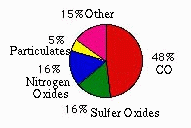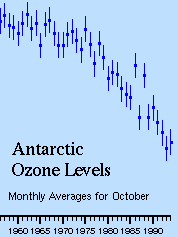Changes in Earth's Atmosphere from Biological Activity
 Cyanobacteria. Creators of our Oxygen Atmosphere
Cyanobacteria. Creators of our Oxygen Atmosphere
Still around today, cyanobacteria are aquatic (live in water) and
photosynthetic (can manufacture their own food). They are extremely
small, usually unicellular, though can form large colonies. They
have been identified in fossils more than 3.5 billion years old.
Cyanobacteria have been tremendously important in the shaping of Earth's atmosphere. Via photosynthesis, they are responsible for having brought about Earth's Oxygen Atmosphere beginning about 3.5 billion years ago and it continues today. Oxygen gas was a pollutant at the time.
 Modern Pollutants
Modern Pollutants
Carbon monoxide is a odorless, poisonous gas. It is created when
gasoline does not completely burn. 60 million metric tons of carbon
monoxide gets put into the air each year in the United States.
Many fear the release of so much carbon in the air will trigger
Global Warming
due to a heightened greenhouse effect.
Will the Earth's carbon cycle buffer us to the changes?
It's not really known. If the temperature of the Earth rises, then the
oceans may absorb more carbon. However, the damage will already be
done. Predicted changes 1) Heat waves, 2) Sea levels
rising and coastal flooding, 3) Glaciers Melting, 4)
Arctic and Antarctic warming. These signposts of global warming may
already be occurring. By the time we confidently measure
a change in temperature, it will already be too late. We are running
an uncontrolled, irreparable experiment.

 What about the
Ozone Hole?
What about the
Ozone Hole?
Ozone naturally forms high in our atmosphere (about 15-30 km
up) where a thin amount of oxygen resides. Up there, ultraviolet light
is able to penetrate and break up the O2, and some of it
reforms as O3, ozone. Ozone absorbs X-ray and UV light quite
well, not allowing it to penetrate through the rest of the atmosphere to
the surface.
The effect of CFCs
CFCs -- "ChloroFluoroCarbons" are released into the air where the
complex molecule is broken up. Chlorine and Bromine atoms make their
way to the ozone layer in the stratosphere, and tie up the
oxygen atoms to keep them from forming into ozone. The effect was
heightened in the Antarctic because of unique conditions conducive
to ozone destruction, though the effect spreads to mid-latitudes.